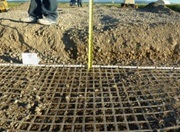
Contact Details:
Tensar International
Cunningham Court
Shadsworth Business Park
Blackburn
Lancashire
BB1 2QX
United Kingdom
Tel: +44 1254 266842
Send Enquiry | Company Information

Geogrids? How could a generation of researchers and practicing engineers get it so wrong? Tensar Res
Company News Thursday, March 26, 2015: Tensar International
If the findings of a recent US study are taken on face value, then over 30 years of research and practical experience with the use of geogrids can be discarded. Researchers Cuelho, Perkins and Morris have concluded that a light-weight, non-woven geotextile outperformed biaxial and multi-axial geogrids in weak soil applications.
The recent research study at the Western Transportation Institute of Montana State University by Eli Cuelho, Steve Perkins and Zachary Morris of Montana State University found that, in a trafficking trial, two geotextile products, a light-weight non-woven and a high-strength woven product, outperformed eight out of the ten different geogrids used for subgrade stabilisation from different manufacturers that were included in the testing. The higher strength fabric outperformed all of the geogrids in the study. Significantly, all of the test sections for all the different types of geosynthetic products used in this study underperformed compared to the researchers own designs.
Engineers at Tensar International have studied the published report and have strong disagreements with the test set-up, reporting of results and the conclusions drawn by the researchers from the test data.
The results are at considerable variance with many previous trafficking studies conducted by the US Corps of Engineers, UK Transport Research Laboratory and others and with the majority of field experience with geosynthetics, including three decades of documented experience and project success using geogrids for stabilisation of unbound aggregates throughout the world.
As in Phase 1 of testing, all of the test sections failed prematurely. The results do not align with either the expected performance of the Experimental Design included in the study report or the performance predicted by current state-of-the-practice design (Giroud-Han method). There are many reasons for this and some lessons that could have been learned from the Phase 1 testing do not appear to have been incorporated in the Phase 2 testing. Tensar’s Engineers have identified a number of construction related issues which Tensar believes will have influenced the results.
The method used, that of screeding the aggregate into place, does not accord with standard industry installation practice. There was no consideration given to the need for a separation layer between the artificial subgrade soil and the poor quality rounded aggregate used as a base material. Importantly there were inconsistencies in the width of geosynthetic coverage - some of the test sections were constructed with the geosynthetic not extending to the full width of the test section whilst in others it did. For example TriAx only covered 80% of the test lane width and was 25% narrower than the apparently best performing products that covered the full test lane.
The results of the study will not change Tensar’s design approach with its own products (validated by an independent third party), or the construction and installation advice it provides to customers in relation to its own products. Engineers and contractors are recommended to follow accepted methods for both design and construction practice in order to obtain full benefit from the use of geosynthetics for subgrade stabilization.
